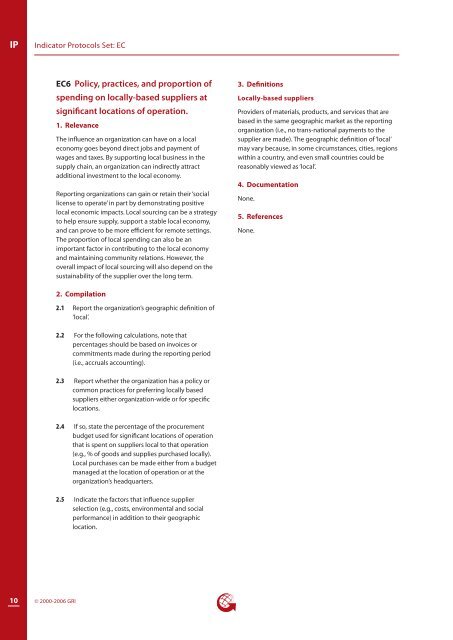Indicator Protocols Set Economic (EC) - Global Reporting Initiative
Indicator Protocols Set Economic (EC) - Global Reporting Initiative
Indicator Protocols Set Economic (EC) - Global Reporting Initiative
Create successful ePaper yourself
Turn your PDF publications into a flip-book with our unique Google optimized e-Paper software.
IP<br />
<strong>Indicator</strong> <strong>Protocols</strong> <strong>Set</strong>: <strong>EC</strong><br />
<strong>EC</strong>6 Policy, practices, and proportion of<br />
spending on locally-based suppliers at<br />
significant locations of operation.<br />
1. Relevance<br />
The influence an organization can have on a local<br />
economy goes beyond direct jobs and payment of<br />
wages and taxes. By supporting local business in the<br />
supply chain, an organization can indirectly attract<br />
additional investment to the local economy.<br />
<strong>Reporting</strong> organizations can gain or retain their ‘social<br />
license to operate’ in part by demonstrating positive<br />
local economic impacts. Local sourcing can be a strategy<br />
to help ensure supply, support a stable local economy,<br />
and can prove to be more efficient for remote settings.<br />
The proportion of local spending can also be an<br />
important factor in contributing to the local economy<br />
and maintaining community relations. However, the<br />
overall impact of local sourcing will also depend on the<br />
sustainability of the supplier over the long term.<br />
3. Definitions<br />
Locally-based suppliers<br />
Providers of materials, products, and services that are<br />
based in the same geographic market as the reporting<br />
organization (i.e., no trans-national payments to the<br />
supplier are made). The geographic definition of ‘local’<br />
may vary because, in some circumstances, cities, regions<br />
within a country, and even small countries could be<br />
reasonably viewed as ‘local’.<br />
4. Documentation<br />
None.<br />
5. References<br />
None.<br />
2. Compilation<br />
2.1 Report the organization’s geographic definition of<br />
‘local’.<br />
2.2 For the following calculations, note that<br />
percentages should be based on invoices or<br />
commitments made during the reporting period<br />
(i.e., accruals accounting).<br />
2.3 Report whether the organization has a policy or<br />
common practices for preferring locally based<br />
suppliers either organization-wide or for specific<br />
locations.<br />
2.4 If so, state the percentage of the procurement<br />
budget used for significant locations of operation<br />
that is spent on suppliers local to that operation<br />
(e.g., % of goods and supplies purchased locally).<br />
Local purchases can be made either from a budget<br />
managed at the location of operation or at the<br />
organization’s headquarters.<br />
2.5 Indicate the factors that influence supplier<br />
selection (e.g., costs, environmental and social<br />
performance) in addition to their geographic<br />
location.<br />
10<br />
© 2000-2006 GRI

















